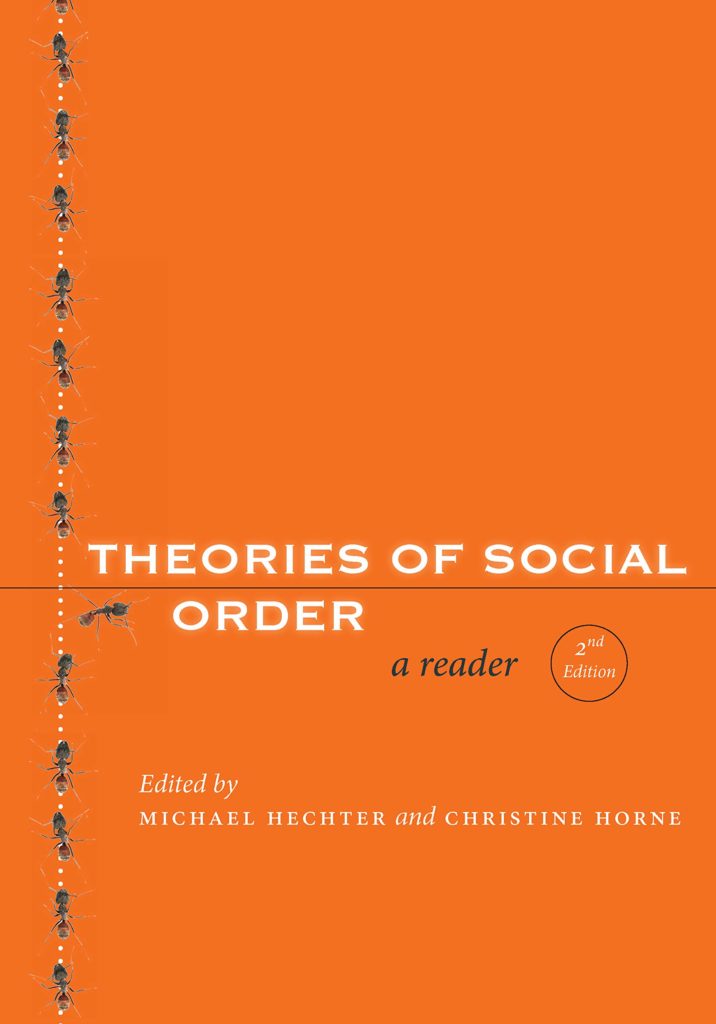
Grupos e redes (Hechter e Horne 2003)
HECHTER, Michael; HORNE, Christine. 2003. Groups and networks. In: M. Hechter; C. Horne (Eds.). Theories of social order: a reader. Stanford: Stanford University Press, pp.283-90.
REGULATION & COOPERATION:
[U]nregulated interaction does not necessarily lead to increased cooperation. (Hechter; Horne 2003:283)
WELLFARE STATE as EMPIRICAL CRITIQUE of the INVISIBLE HAND THEORY:
Indeed, the fact that all advanced capitalist countries today have adopted some form of welfare state constitutes a strong empirical critique of the invisible hand theory of social order. (Hechter; Horne 2003:283)
CAOS or PREDICTABILITY or COOPERATION:
It appears, therefore, that unregulated, self-interested interactions may lead to chaos or to predictability or to cooperation. For spontaneous order theorists, one of the challenges is to identify the conditions under which interaction produces these different outcomes. (Hechter; Horne 2003:283)
STRUCTURES OF AFFILIATION (ties within & across groups):
In fact, in all societies, people belong to a variety of groups – families, neighborhoods, churches, athletic clubs, businesses, and so forth. Order within these groups is related to order in the larger society, sometimes in complex ways. Group and network theories explicitly focus on structures of affiliation and their consequences for social order. They advance two basic arguments. One is that ties across groups increase order; the other is that ties within groups are key.(Hechter; Horne 2003:284)
SIMMEL (compulsory X voluntary association):
Simmel distinguishes between two different patterns of group affiliation. In the older pattern, characteristic of feudal Europe, group affiliations are concentric. That is, membership in one group implies membership in others. for example, if you live in Boston, you are simultaneously a “member” of the respective citizenries of Massachusetts, New England, and the United States. When groups are organized concentrically, individuals usually do not belong to groups outside the circle. […] The modern form of group affiliation is quite different. By and large, modern groups are voluntary rather than compulsory. In consequence, for the first time in history, individuals are free to join socially heterogeneous groups. When groups are organized in this way, people may simultaneously be members of many groups. These multiple memberships create bridging ties across groups. (Hechter; Horne 2003:284)
GRANOVETTER (the strenght of weak ties):
Granovetter discusses two different kinds of social ties that can link individuals. Strong ties (such as those between family members and close friends) are time-intensive, emotional, intimate, and reciprocal. Weak ties (such as those between casual acquaintances), however, are fleeting, instrumental, and impersonal. Weak ties may not appear to contribute much to social order. But Granovetter argues that despite this intuition, these ties indeed are very important. Weak ties serve as bridges between socially homogeneous groups whose members ordinarily do not interact with one another. In contrast, strong ties tend to produce groups thbat are inward looking and hostile to outsiders. It follows that a complex society having a preponderance of strong ties is vulnerable to intergroup conflicht and therefore to social disorder. In contrast, a society having a preponderance of weak ties has more interroup relations and, as a result, greater levels of social order (Blau and Schwartz 1984). (Hechter; Horne 2003:284-5)
WEAK TIES & SOCIAL ORDER (ethnographic evidence on exogamy)
In most tribal societies, individuals are prohibited from marrying within their group. This norm compels individuals to seek mates from different tribal groups. The resulting marriages forge weak ties between different tribes. (Hechter; Horne 2003:285)
GLUCKMAN (conflicting loyalties):
Men can only belong to a large society through intermediate smaller groups, based on technical process, on personal association, on locality, on sectarian belief within a larger cult, and so forth. Schools which are organized in houses cutting across forms, and Universities which have colleges cutting across departments and faculties, exhibit more cohesion than amorphous schools and universities. Tight loyalties to smaller groups can be effective in strenghthening a larger community if there are offsetting loyalties. The feud is, according to the dictionary, “a lasting state of hostility.” There is no society which does not contain such states of hostility between its component sections; but provided they are redressed by other loyalties they may contribute to the peace of the whole. . . . Conflicting loyalties and divisions of allegiance tend to inhibit the development of open quarrelling, and . . . the greater the division in one area of society, the greater is likely to be the cohesion in a wider range of relationships – provided that there is a general need for peace, and recognition of a moral order in which this peace can flourish. (Gluckman 1955, 24-25) (Hechter; Horne 2003:285-6)
GELLNER (to “gang up”)
[A]nyone who commits an act of aggression against any one of us must expect retaliation from us all, and not only will the aggressor himself be likely to suffer retaliation, but his entire group and all its members will be equally liable (Ernest Gellner; In: Hechter; Horne 2003:287)
TOCQUEVILLE (voluntary associations):
Alexis de Tocqueville is the first European scholar to emphasize the importance of voluntary groups for social order. […] Tocqueville argues that freedom of association is no threat to social order but – on the contrary – a boon to it. This is because groups promote cooperation. Voluntary associations essentially serve as schools for democratic decision making and the learning of the virtues and techniques of cooperation. (Hechter; Horne 2003:288)




 LaSPA is located at the Institute of Philosophy and Human Sciences (
LaSPA is located at the Institute of Philosophy and Human Sciences (